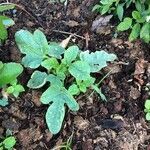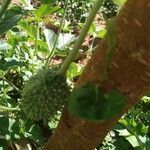Prostrate vines; stems hispid or scabrous with pustulate based trichomes. Leaves broadly ovate or suborbicular, 5-10 cm long, nearly or equally as wide as long, deeply 3-to 5-lobate, the lobes obtuse at the apex, cordate or subtruncate at the base, the middle lobe obovate, the lateral lobes various, usually oblique, the sinuses rounded, the margin undulate dentate, chartaceous, both the surfaces hispid or scabrous; petiole 3-8 cm long, hispid or scabrous. Staminate flowsers axillary, fasciculate or sometimes solitary, short pedunculate; calyx campanulate, the lobes 3-4 mm long, subulate, hispid green; corolla campanulate, the lobes ca. 5 mm long, yellow, obovate, the apex acute, spreading; stamens 3-4 mm long, glabrous, the anthers ca. 2 mm long, the appendix of the connective dilated, deeply 2-lobed, 1-2 mm long, the segments bilobate; pistillode glandlike.
Plants dioecious, roots thin, without thick, woody rootstock. Tendrils setose. Leaves: petiole hispid to setose; blade broadly to narrowly ovate, deeply palmately 3–5-lobed to weakly 3-lobed or nearly unlobed, [sometimes pedately lobed], 3–12(–15) × 2.5–12(–15) cm, length 0.9–1(–2) times width, base cordate, lobes broadly elliptic to obovate, spatulate, or ovate, margins serrate or entire. Inflorescences: pedicels of pistillate flowers distally dilated; staminate flowers 3–10 in racemes, <pedunculate or sessile>; pistillate flowers: calyx lobes 2–4 mm, petals 6–8 mm, corolla tube 0–1 mm, sparsely puberulent inside. Pepos light yellowish green to light yellow, sometimes with light green stripes, usually ellipsoid, rarely obovoid, 2–7 × 1.5–4 cm, surfaces ± aculeate at maturity, flesh greenish white to yellowish green. 2n = 24.
A pumpkin family plant. It is a trailing or climbing herb. It grows 3 m long. It is rough to touch. The leaves are broadly oval and 4-10 cm long by 5-11 cm wide. They have 3-5 deep lobes. The leaves have fine teeth along the edge. It has separate male and female flowers on the same plant. There are 1-10 male flowers with stalks 4-30 mm long. The female flowers occur singly. The stalks are 1-10 cm long. The fruit are broadly oblong and 4-7 cm long. They are covered with soft curved prickles. They ripen to yellow-green with darker bands along them. The seed are 4-6 mm long. The flesh is firm and white.
Pistillate flowsers solitary in the same axils as the staminate flowers; peduncle 4-15 cm long; calyx and corolla as in the staminate flowers; ovary oblong; hispid; stigmas forming a spherical head. Fruits yellow, sometimes with lighter longitudinal stripes, ellipsoidal or ovoid, 4-7 cm long, 3-6 cm in diameter, sparsely prickly with rigid spines; seeds numerous, horizontal, dirty white, oblong, 4-5 mm long, 2.0-2.5 mm wide, the testa smooth or nearly so.
Leaf-lamina 3–10 × 3·5–12–5 cm., broadly ovate in outline, broadly and shallowly cordate, punctate and setulose becoming scabrid-setose on veins beneath, scabrid-setulose becoming punctate above, margins ± sinuate-denticulate, palmately (3)5(7)-lobed, usually deeply, lobes narrowly to broadly elliptic, rhombic, obovate-elliptic or less often ovate-triangular or triangular, obtuse to rounded, apiculate, the central largest, often shortly 3-lobulate.
Prostrate or scandent annual herb. Tendrils solitary at each node. Stems and petioles patent-setulose. Corolla lobes up to 8 mm long. Fruit uniformly yellow when ripe, softly spiny, spines 3-11 mm long; fruit stalk 25-210 mm long, usually exceeding 60 mm, expanding upwards. Flowers yellow.
Fruit 3–4·5 × 2·5–3·5 cm., ellipsoid to sub-globose, softly spiny, at least proximally, green or green striped paler green becoming yellow when ripe; spines 3–11 mm. long; fruit-stalk 2·5–21 cm. long, expanded upwards.
Female flowers solitary, sometimes co-axillary with male; pedicels 18–105 mm. long; ovary 7–9 × 60–9 mm., broadly ellipsoid, shortly rostrate, softly spiny; perianth similar to that of male flower.
male flowers 2–10 in subsessile fascicles; pedicels 6–30 mm. long. Receptacle-tube 2–4 mm. long, lobes 1·2–3 mm. long. Petals 3–7·5 mm. long, yellow.
Seeds 5–6 × 2·2–2·7 × 1·0–1·3 mm., elliptic in outline, compressed, with rounded margins, smooth.
For description of variety occurring in Australia see Cucumis anguria L. var. anguria.
Annual; stems prostrate or scandent, to 3 m., patent-setulose.
Petiole 2–12 cm. long, patent-setulose.
Flowers monoecious.


